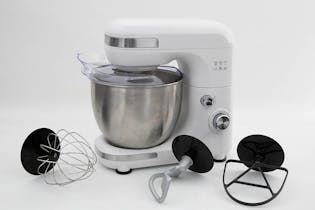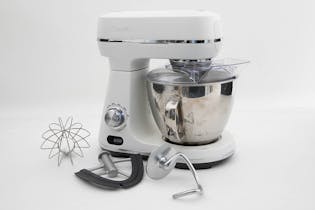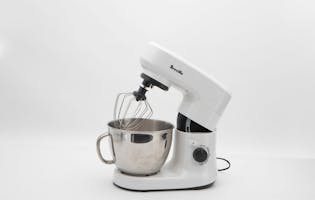Kenwood Chef mixer: a timeless appliance for over 60 years
A history and celebration of the Kenwood Chef A701/A701A.

The electric food mixer is a product that any self-respecting home baker will own and cherish as the ultimate helper for those arduous tasks in the kitchen.
It’s a product that can do everything, from whisking and beating, to mincing, juicing and slicing. It really is indispensable. Reality TV ‘bake offs’ and ‘masterchefs’ probably wouldn’t exist if it wasn’t for these devices.
But in essence, an electric food mixer is a relatively simple product so should last a long time – just a motor, speed controller and gearbox, combined with some attachments, a bowl and the housing. And yet very few machines from yesteryear escape the trip to the landfill.
One machine that has managed to outlive its contemporaries is the Kenwood Chef A701, first sold in 1960.

Mixing past

The origins of our modern electric mixers come from the 19th century and the invention in France of the wire whisk. This was improved upon in the US in 1856 with the first mechanised mixer, patented as the ‘egg beater’. An electric version appeared in 1885, but the first products that more closely resembled the stand mixers we have today came in the early 20th century.
In 1908, Herbert Johnston invented the first electric standing mixer for the Hobart Manufacturing Company. However, these were industrial machines that could mix up to 80 litres and were only used in commercial bakeries.
It wasn’t until 1919 that a version for the home baker was sold: the KitchenAid Food Preparer model H-5 with a capacity of just under 5 litres. Apparently the name came from a wife of one of the company executives, who was testing the model and said “it’s the best kitchen aid I’ve ever had”. The H-5 was priced at US$189.50 when first sold – the equivalent of more than NZ$5000 today!
New Zealand didn’t see electric mixers until the mid 1930s, when imported brands such as Dormeyer, Universal and Hamilton Beach arrived. Sunbeam launched its popular Mixmaster model in 1935 and eventually this was manufactured in New Zealand. Kenneth Wood launched the first Kenwood Chef, the A700 in 1950, and it’s from here that our Design for Life story really starts.
The two Kens
In 1958, Ken Wood decided it was time to update the Chef. He approached the British Design Council, which ran a scheme to match businesses with industrial designers. A young designer, Kenneth Grange, was asked to submit a new design for the Chef, and he told Kenwood that he would do it in three days. Unfortunately he ran out of time to properly make the visual model, so decided to just make half and use a mirror. It didn’t matter as Kenwood loved the design and by 1960, the A701 was being manufactured in the Kenwood factory in Woking, UK.

In 1962, the beater attachment mechanism was changed and the model number updated to A701A, but it was still pretty much the same machine.
Sir Kenneth Grange recalls making the mixer deliberately heavier than the previous model so that customers would associate it with being of a higher quality. Indeed, Consumer issue 94 in 1973 noted that the Chef was twice as heavy as any of the tested machines, at 9.15kg.
Sir Kenneth said: “Slightly heavier says longer life, better value, so I asked them [Kenwood] to use a particular material that is heavier and certainly weightier in the fingers.”
When we consider the aesthetic of the A701 compared with the previous model, we can see what a radical change in style this product was. The A700 had the styling of the streamlined Art Deco era, whereas the A701 was truly a modern interpretation of what a mixer should look like: simple, straight and honest lines and forms. If you put it next to a modern Kenwood Chef, you will notice that the design language hasn’t really changed in 60 years – a testament to Sir Kenneth’s design.
His design philosophy was certainly one of form following function. He wanted products to be straightforward uncomplicated to use, but also to be robust and never fail.
And he didn’t forget about the connection consumers have with objects.
“You have to be pleased to own something and be happy that you have it, whatever it is – be it a pair of old socks, a hat or a handbag. In the moment you pick it up, you must be pleased to do it.
“I think there is great reward in going through a day enjoying everything that you are using. These things then become important and personal, and you don’t want to lose them. Be it a pen or a notebook or whatever, they become reliable friends. The marvellous thing about our world is that it can be very rewarding even at the most modest level.“
Consumer NZ member John Wall from Palmerston North echoes Sir Kenneth’s sentiment. His A701A is more than 40 years old and is still going strong.
“You know, it's kept going amazingly well,” he told us. “I like the look of it. It's a very serviceable article of homeware to look at … It's got a sort of warm, usable look about it.”
John regularly uses his Chef to make shortbread and fruit cake, and every new resident of the retirement village where he lives is given a fruit cake as a ‘welcome to the village’ gift. The shortbreads bear John’s croquet insignia as he is an avid player of the game, and also a golf croquet senior referee and examiner. He also uses the juicer attachment to juice lemons for ginger beer. Over its 40+years of service, the A701A has helped produce many delicious treats for the Wall family, with only one mechanical failure so far.
“It had to have the gearbox repaired. You know, it just sort of broke down. We got that repaired and that was okay. That was probably 25 years ago.”
So what does John like about his Chef?
“Firstly, the fact that it's got a plastic bowl, it's not a metal bowl – because I can then put butter into the bowl from the fridge, and then soften it up in the microwave. Second thing that springs to mind is that the variable speed control starts off very slow, which I like. And the fact that it's so easy to put the juicing attachment on.”
Fixing and mixing
Harvey Wilson writes a blog called Once Around The Block. He has restored an A701 and details his experience online – an invaluable resource if you are considering doing the same. He bought his A701 from Heather Mackay, who told him:
“This Kenwood was my Mum’s. I would imagine it was a wedding present … my Mum loved to bake, and she whipped up many wonderful creations with it, and of course my sister and I enjoyed many happy times scraping out the mixing bowl. I also remember watching Mum mince up cooked meat as well, to make shepherd’s pie. I am amazed at its condition considering its age, but my parents looked after their possessions.”

One of the main jobs that Harvey details on his A701 restoration blog post, is the cleaning and regreasing of the gearbox. A recent episode of the TV show The Repair Shop also features an A701, and they too clean and regrease the gearbox to get the unit running again. It’s these basic servicing tasks that often get overlooked and can cause products to malfunction.
Andrew Wadsworth runs Wellington Appliance Servicing Ltd in Lower Hutt and has seen a fair few Chefs over the years. He reckons he sees two or three of them a week for repairs.
“A lot of them are on their second generation now …. Original owners have died and the grandkids or kids are going into their houses and cleaning them and finding the Chefs, bringing them in and wanting me to get them going again, sometimes just for sentimental value.”
Andrew has been servicing appliances for more than 30 years. For 20 years he worked as service guy for LV Martin in Wellington - “it’s the putting it right that counts”. Well Andrew was the one putting it right.
Recently he has focused on smaller appliances such as coffee machines, vacuum cleaners and microwaves, along with food mixers.
Of the Kenwood A701, he said it’s “just a simple design and good-quality raw materials”.
We asked what the common problems with this mixer are. Often, it’s as simple as replacing cords and plugs because the original ones just aren’t that durable, or have been burnt on stove elements. Motor brushes can wear out, but replacements are readily available as it’s a pretty generic motor, and getting the motor out and replacing the brushes is reasonably straightforward.
“Occasionally you will get one with a broken gearbox. But that's it. It's pretty hard to break a gearbox on one of these,” Andrew said.
Often products are thrown away if parts cannot be sourced, but both Harvey and Andrew can source parts for the Chef online here in NZ and from overseas websites to repair and service their machines. Websites such as www.kenwoodchefrestore.co.uk have parts and service kits available, along with downloadable instruction manuals. And there is also a www.ifixit.com page dedicated to the A701A detailing how to disassemble it. There are even sites with 3D-printed parts to order or download.
Clearly, it’s a model that has a following.
Andrew told us: “I don't charge a lot to repair them because they're just an old cake mixer. The trouble is, if I charge my normal charge out rate, no one would get them fixed because they’d be too expensive. It's still worth my while to do and it's also economical for the customer.”
It’s great that Andrew has decided to increase the longevity of this product through this service he provides. A durability hero, in our opinion.
We asked him what brand of modern mixer he would recommend and unfortunately his opinion of the modern Kenwood isn’t that high.
“They went to Chinese production in the 1990s and the reliability went down; they now have plastic gears in the gearbox. The quality of the materials is nothing like what it used to be.”
Andrew believes you should also avoid Sunbeam products due to the lack of spare parts available. If you want a reliable mixer, it seems that KitchenAid is the brand to go for. He says they are as reliable as an A701.
Production of the A701A ceased in 1976; it was superseded by the A901, which Andrew also recommends: “They [the A901s] go for about 40 years and then they burn out the speed controllers and that’s only because they had old paper film capacitors, which break down with age and burnout. You can rebuild the old speed controller with new capacitors and away they go again, for another 40 years.”
The Kenwood company was bought in 2001 by DeLonghi, which unfortunately doesn’t seem to have the same attitude towards durability. A recent investigation by Consumer found that a faulty Kenwood mixer that was returned was just shredded and recycled, with no attempt at repair.
Knight of Design

Sir Kenneth Grange was knighted in 2013 for his services to design. After designing for Kenwood, he went on to become one of the most successful British industrial designers. His designs include cameras for Kodak, the iconic Inter-City 125 train for British Rail in the 1970s, and the 1997 redesign of the iconic London taxi.
A common theme of Sir Kenneth’s designs has been that of usability and durability, and the A701 might just be one of his most successful designs in this respect.
In an interview with the Victoria and Albert Museum in London this year, he said: “I’m of an age where repair was commonplace, and you’d never think of not repairing something, be it your bicycle or your trousers. Whatever it was, it was repairable and that makes a big difference to a person’s outlook. What better merit can you give a product than knowing it is actually going to outlast you?”
We've tested 22 food mixers.
Find the right one for you.



Member comments
Get access to comment